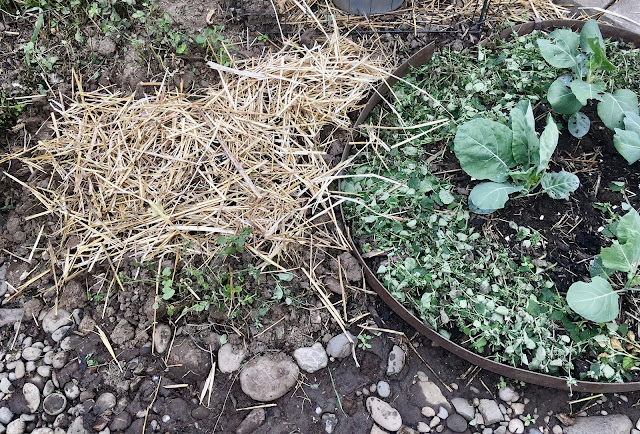But if I can be strong, get on my rain gear, and take a daily tour of my garden, I find many simple things to do, without getting too muddy. The best tip I've read in any permaculture blog Is this: Be consistent with 15-minutes a day, year round.
I try to take a 15-minute walk through my garden each day, and I alternate the front and back gardens so I don't feel rushed. The consistency of the 15-minute daily visit keeps me connected to my garden even when I don't accomplish much. I notice the changes of the season, and how many bees I still have. As Amy from 10-Acre Farm says, "It helps me to enjoy 'being' in the garden, rather than always focusing on the 'doing'."
Agenda:
1. October harvest
2. Save seeds
3. October garden care and bedding down
4. Fall planting
5. Raspberry pruning and thinning
1. October harvest:
Our grape harvest was a total loss this year, for some reason- half the grapes were small and green still, and the rest were small and sour.
2. Save seeds:
I've finished harvesting seeds. My beans are all dry and ready to stored away. Today I will put them into a labeled envelope, and store all my seeds in a zip-lock bag in the refrigerator, near the bottom, away from the freezer. (Note to self: Next spring, take bags out but keep them closed until the seeds warm, so moisture in the air doesn’t condense on the seeds.)
3. October garden care and bedding down:
In October, after harvesting, I'm mostly putting beds to rest, called bedding down: Some garden beds get to truly rest for a spell, and this is my last chance to prepare the soil for winter, and for planting next spring, weed free and "packed full of nutrients".
 |
| Mulch: Straw over winter garlic and chopped lemon balm around my Brussels sprouts |
In summer, mulch retains moisture and prevents weeds. In winter, mulch protects against erosion from heavy rains, and stabilizes the soil temperature. (If I still have plants growing, I keep mulch at least an inch away from the plant stems.)
Green cover crops (live plants) also make good mulch and add nutrients. I'ill plant a cover crop of fava beans or clover in some of the empty beds. Later I will cut them back and put the plants on the beds as mulch, to allow the nitrogen to leech into the soil.
This is the month to plant garlic, spring bulbs, and many native seeds and plants, as well as cover crops.
I finally got the garlic in yesterday, and the two remaining kale starts.
5. Raspberry pruning and thinning:
The other big task in October is fall pruning. I need to prune the hedge, the roses, and the raspberries.
 I have a difficult raspberry bed, because I have two varieties -summer and everbearing - all mashed in together. (And they are overgrown. I need to thin them out before spring.) It’s important to understand how raspberries fruit, because raspberries are pruned after they finish fruiting, and if the wrong canes are pruned away, the season’s crop will be lost!
I have a difficult raspberry bed, because I have two varieties -summer and everbearing - all mashed in together. (And they are overgrown. I need to thin them out before spring.) It’s important to understand how raspberries fruit, because raspberries are pruned after they finish fruiting, and if the wrong canes are pruned away, the season’s crop will be lost!All raspberry plants are perennial, their crowns and roots are perennial (living many years), but individual canes are only short-lived. The life of the canes and when they fruit differs with the different raspberry varieties.
The canes of summer bearing raspberries live for two years: This year's new growth (known as primocanes) will overwinter to become next summer's fruiting canes (known as floricanes), and die back shortly after fruiting. I usually take out some of these old floricanes in September, leaving a foot or more of the cane to give native bees a possible roost for laying their eggs for next spring.
Everbearing raspberries also live for two years: They produce fruit on the tips of first-year primocanes in autumn, and then produce a larger summer crop on the lower portion of these same canes in their second year (second-year floricanes). The first year primocanes are still producing berries now, but I often begin to prune out the floricanes this month.
How do I distinguish first-year canes from second-year canes?First-year canes have green stems, while second-year canes have a thin, brown bark covering them.
Raspberries are vigorous growers, and they will sucker! They produce runner or stolons, which are horizontal running underground stems that will move out to other parts of the garden, which root and shoot to produce more raspberry plants. I've let too many of these grow into plants, and my bed is crowded. This is the best month to dig these out to give away. I'm aiming to leave plants that are at least 2 feet apart (because they will fill in again quickly!)



No comments:
Post a Comment